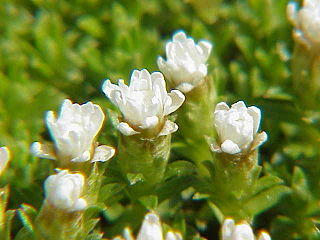
Solanum aviculare, commonly called poroporo or pōporo, bumurra (Dharug), kangaroo apple, pam plum (Australia), or New Zealand nightshade, is a soft-wooded shrub native to New Zealand and the east coast of Australia.

Olearia, most commonly known as daisy-bush, is a genus of flowering plants belonging to the family Asteraceae, the largest of the flowering plant families in the world. Olearia are found in Australia, New Guinea and New Zealand. The genus includes herbaceous plants, shrubs and small trees. The latter are unusual among the Asteraceae and are called tree daisies in New Zealand. All bear the familiar daisy-like composite flowerheads in white, pink, mauve or purple.

Intsia bijuga, commonly known as Borneo teak, ipil, Johnstone River teak, and kwila, amongst many other names, is a species of tree in the flowering plant family Fabaceae, native to coastal areas from east Africa, through India and Southeast Asia to Australia and the western Pacific. It has significant importance to indigenous cultures in many parts of its range, but is also threatened by illegal logging due to its high quality timber. It is most commonly found in tropical coastal forests.

Phormium colensoi, also called mountain flax, or wharariki in Māori, is a perennial plant that is endemic to New Zealand. The greenish, yellow or orange flowers are followed by twisted seed pods. It is less common than the other Phormium species, P. tenax or harakeke. Mountain flax is also called whararipi, whatariki, mangaeka, kōrari tuauru, wauraki, coastal flax, hill flax and lesser New Zealand flax.

Arctostaphylos hookeri is a species of manzanita known by the common name Hooker's manzanita.

Gazania rigens, sometimes called treasure flower, is a species of flowering plant in the family Asteraceae, native to coastal areas of southern Africa. It is naturalised elsewhere and is widely cultivated as an ornamental plant.

Raoulia is a genus of New Zealand plants in the tribe Gnaphalieae within the family Asteraceae.

Celmisia spectabilis, also known as cotton daisy or by its Māori name puharetaiko, is a mountain daisy in the family Asteraceae, and is endemic to New Zealand, where it is one of the most widespread species in the genus Celmisia.

Pleurophyllum hookeri, also known as the silver-leaf daisy or sage-green rosette herb, is a herbaceous plant in the family Asteraceae, a megaherb native to the subantarctic Auckland and Campbell Islands of New Zealand and Australia’s Macquarie Island. It grows up to 900 mm in height and has crimson button flowers and long, silky, silver leaves, with a large carrot-like tuber and long roots. It also has the unusual feature of a vertically contractile stem, most of which is underground, which serves to keep the leaf rosette close to the ground surface and the plant anchored securely against the very strong winds typical of subantarctic islands. Prior to the successful eradication of introduced mammals on Macquarie Island in 2011, it had been threatened there by black rats and European rabbits.

Azorella polaris, commonly known as the Macquarie Island cabbage, is a species of flowering plant usually placed in the family Araliaceae or Apiaceae and only very distantly related to cabbage. It is a megaherb, growing up to about a metre in height, native to the subantarctic islands of New Zealand and to Australia’s Macquarie Island.

Leptinella plumosa is a small flowering plant in the daisy family. It is a circumantarctic species found on many subantarctic islands in the Southern Ocean. The specific epithet comes from the Latin for “feathery”, referring to the form of the leaves.

Lucy Beatrice Moore was a New Zealand botanist and ecologist.

Olearia arborescens, also known as common tree daisy and pekapeka by Māori, is a common shrub or small tree of New Zealand. It has also been called the Glossy Tree Daisy and the Forest Tree Daisy. It grows in lowland to alpine scrubland in the North Island from East Cape southwards, and throughout the South and Stewart Islands. Olearia arborescens was previously known as Solidago arborescens.

Phormium is a genus of two plant species in the family Asphodelaceae. One species is endemic to New Zealand and the other is native to New Zealand and Norfolk Island. The two species are widely known in New Zealand as flax or their Māori names wharariki and harakeke respectively, and elsewhere as New Zealand flax or flax lily, but they are not closely related to the Northern Hemisphere's flax, which is native to the region extending from the eastern Mediterranean to India and has been used by humans since 30,000 B.C.

Iris setosa, the bristle-pointed iris, is a species of flowering plant in the genus Iris of the family Iridaceae, it belongs the subgenus Limniris and the series Tripetalae. It is a rhizomatous perennial from a wide range across the Arctic sea, including Alaska, Maine, Canada, Russia, northeastern Asia, China, Korea and southwards to Japan. The plant has tall branching stems, mid green leaves and violet, purple-blue, violet-blue, blue, to lavender flowers. There are also plants with pink and white flowers.

Conospermum hookeri, commonly known as Tasmanian smokebush, is a species of flowering plant in the family Proteaceae and is endemic to Tasmania. It is a shrub with many branches, spatula-shaped or linear leaves, panicles of spikes of white, tube-shaped flowers and reddish brown nuts covered with silky fawn-coloured hairs.

Townsendia hookeri is a perennial, flowering plant in the family Asteraceae. It is often referred to by the common names Easter daisy or Hooker's Townsend daisy. Named after 19th century botanist William Jackson Hooker, T. hookeri shares the genus Townsendia with at least 28 other species at this time.

Megaherbs are a group of herbaceous wildflowers growing in the New Zealand subantarctic islands and on the other subantarctic islands. They are characterised by their great size, with huge leaves and very large and often unusually coloured flowers, which have evolved as an adaptation to the harsh weather conditions on the islands. They suffer from overgrazing due to introduced mammals.

Celmisia major is a species of daisy that is endemic to New Zealand. It is split into two different varieties, Celmisia major var. major and Celmisia major var. brevis. Despite being in the same species, it is thought that the two varieties are not close to one another, with botanist Peter James de Lange stressing critical study on the taxonomy of the daisies. It was first described by Thomas Cheeseman in 1925. The major variety is found in the Auckland area and nearby islands, while the brevis variety is confined to Mount Taranaki.

Helichrysum lanceolatum is a species of plant endemic to New Zealand, commonly known as niniao.






















